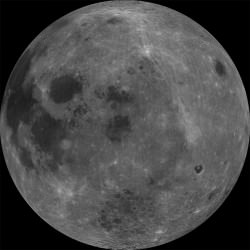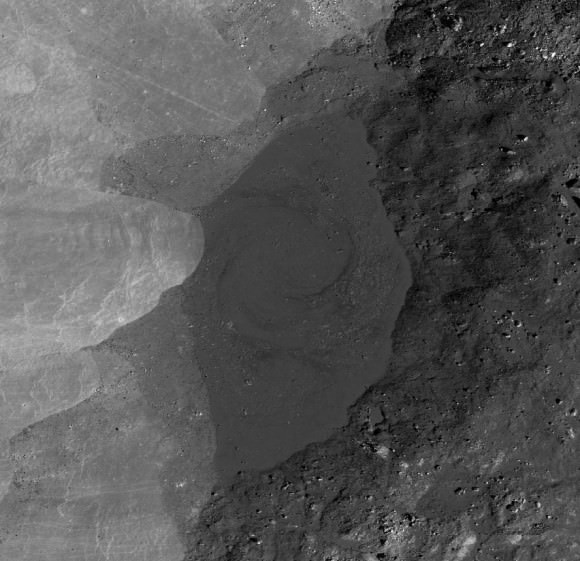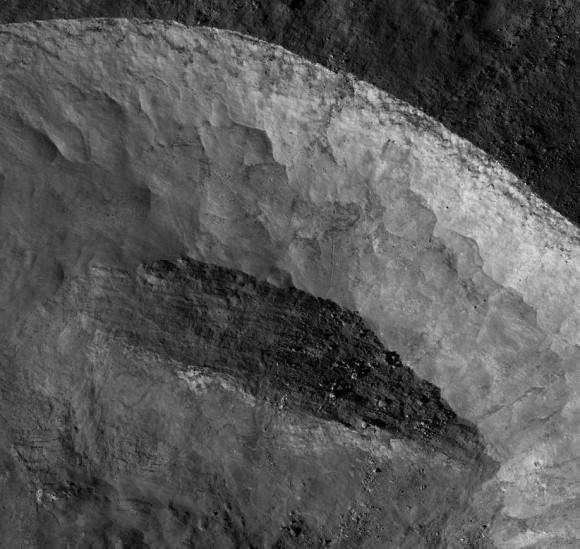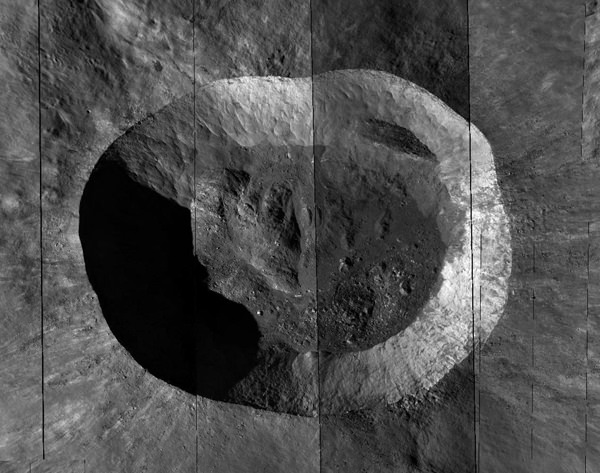[/caption]
The Moon is covered with craters of various shapes and sizes, and in various states of preservation. Scientists have studied these spectacular features for over five decades, yet there are still many things about craters that we just don’t understand. The study of craters is important because we use them to determine the ages of planetary surfaces. Now, very high resolution imagery from the Lunar Reconnaissance Orbiter Camera (LROC) is allowing us to see lunar craters as never before. Under such scrutiny, one very fresh crater is revealing a host of secrets about the crater-forming process and revealing that it’s not as young as some people may have originally thought.
The crater in question is Giordano Bruno, a 22 km diameter crater located on the far side of the Moon, just beyond the eastern limb. Like all craters on the Moon, this one was named after a famous scientist, in this case, a sixteenth century Italian philosopher who was burned at the stake in 1600 for proposing the existence of “countless Earths.” Because of its position on the far side, Giordano Bruno crater was not seen by humans until it was photographed by the Soviet Luna-3 mission in 1959. But then, this crater was immediately recognized as one of significance, because of its very bright and extensive ray system.

Image credit: NASA/JPL/USGS
Along with its bright rays, the crisp rim of the crater, it’s very steep slopes, and a lack of observed superposed craters all argued for a very young age for this intriguing crater. Some researchers even suggested that the formation of this crater was observed by medieval monks in 1178, and recorded as a lunar transient event. Other workers think the age should be closer to 1 million years old. This is still very young by the standards of similar-sized lunar craters, but not within written history.
Over the past 2 years, the acquisition of LROC data has allowed Giordano Bruno crater to be studied in much greater detail than ever before. Images taken by the LROC Narrow Angle Cameras (NAC’s) have resolutions of about half a meter per pixel. This means that something the size of a chair would take up one pixel, and your kitchen table would be roughly resolvable as a 2 x 3 pixel rectangle. With resolutions like that, interesting and unexpected features are being revealed.
One of the most spectacular features is a swirl of impact melt on the western edge of the crater floor. This whirlpool-like structure shows that the melt here underwent chaotic mixing while it was liquid. You can also see that parts of the melt are actually mixtures of real melt and rock fragments that have been incorporated during movement of the melt.

Image credit: NASA/GSFC/Arizona State University
Recently published work by Dr. Yuriy Shkuratov (from the Astronomical Institute of Kharkov in Ukraine) and his colleagues used a new technique to study this swirl. Multiple images taken under different conditions were combined to provide roughness calculations for the area. Their research shows that there is a depression in the centre of this structure and that higher segments of the whirlpool swirl exhibit greater roughness than the surrounding melt. They interpret this to mean that the cooling impact melt pool was disturbed by melt flows coming off the crater walls. These incoming flows were more viscous because they had incorporated rock fragments and so did not mix as readily with the other melt material.
One of the other features studied by Dr. Shkuratov and his team is a large slump of wall material near the northern rim of Giordano Bruno. Such slumps are common in larger craters and are believed to form during the late stages of crater formation. This means that the slump block should be the same age as the crater. However, Dr. Shkuratov and colleagues have found that, while there are no craters on the slumped material, a number of small craters are located on the inner wall near this large landslide. They interpret this to mean that the slump is a more recent event. This is significant, because up until now, such big changes were not thought to occur so long after crater formation.

Image credit: NASA/GSFC/Arizona State University
The most intriguing result of Dr. Shkuratov’s study is the indication of a not-so-young age for Giordano Bruno. A number of very bright landslides, much smaller than the one on the north wall, are observed around the crater. Similarly, small bright craters are found superposed on many parts of the crater walls. These landslides and craters are much brighter than the surrounding materials. On the Moon, brighter means younger, since materials tend to darken as they age, due to a process called “space weathering.” If these craters and landslides are indeed young, this means that the surrounding darker material of Giordano Bruno crater must be older. Data from Japan’s Kaguya mission confirms that these variations in brightness are not related to compositional variations, and so must be age-related. Based on this and other evidence, Dr. Shkuratov’s team conclude that Giordano Bruno crater must be at least one million years old.
So, whatever the medieval monks saw when they recorded the occurrence of a lunar transient event in 1178, it was not the impact that formed Giordano Bruno crater.
Discover the secrets of Giordano Bruno crater for yourself, using LROC data at the ACT-REACT Quick Map web site
Source: The lunar crater Giordano Bruno as seen with optical roughness imagery. Shkuratov et al., Icarus 218, 2012, 525-533, doi:10.1016/j.icarus/2011.12.023.


The impact event that created Giordano Bruno would also have created an epic, day-long meteor shower, while there exist no records of such an event in 1178. NASA has a page on the 1178 Canterbury passage and its’ alleged relation to the crater: http://science.nasa.gov/science-news/science-at-nasa/2001/ast26apr_1/
Looks like this is more evidence for an ancient origin.
This article is the first time I read of “Giordano Bruno” . It’s amazing that 500 years back someone could comprehend the convept of infinity and how it applied to space and time.
Some of his ideas were so radical that it is only recently that we can confirm most of what he said is true. His theory of a “transcendental God” is something that Physicists are striving to answer now.
One of the rare breed of people who would rather die than change his ideals.